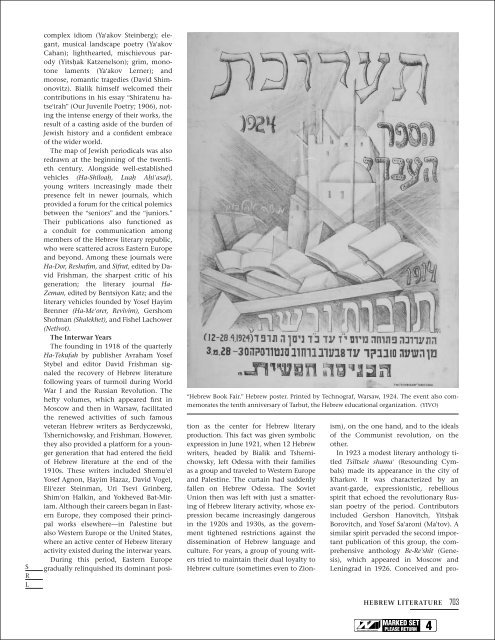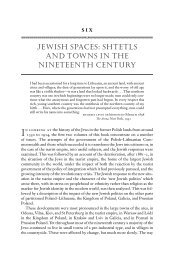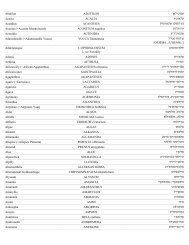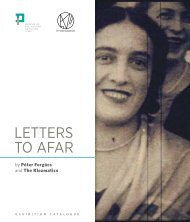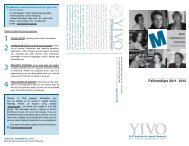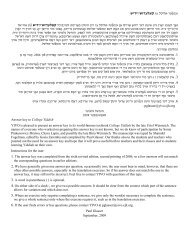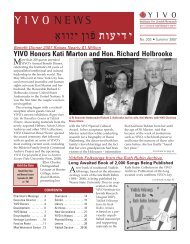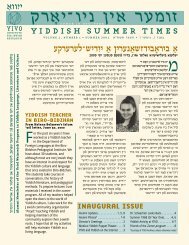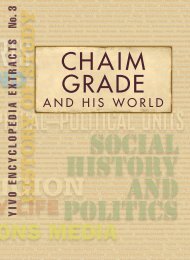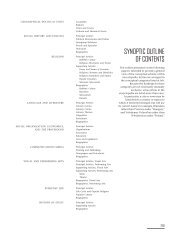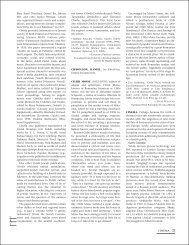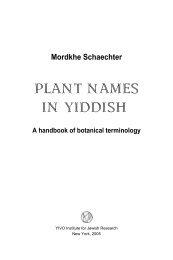Hebrew literature - YIVO Institute for Jewish Research
Hebrew literature - YIVO Institute for Jewish Research
Hebrew literature - YIVO Institute for Jewish Research
Create successful ePaper yourself
Turn your PDF publications into a flip-book with our unique Google optimized e-Paper software.
S<br />
R<br />
L<br />
complex idiom (Ya‘akov Steinberg); elegant,<br />
musical landscape poetry (Ya‘akov<br />
Cahan); lighthearted, mischievous parody<br />
(YitsÕak Katzenelson); grim, monotone<br />
laments (Ya‘akov Lerner); and<br />
morose, romantic tragedies (David Shimonovitz).<br />
Bialik himself welcomed their<br />
contributions in his essay “Shiratenu hatse‘irah”<br />
(Our Juvenile Poetry; 1906), noting<br />
the intense energy of their works, the<br />
result of a casting aside of the burden of<br />
<strong>Jewish</strong> history and a confident embrace<br />
of the wider world.<br />
The map of <strong>Jewish</strong> periodicals was also<br />
redrawn at the beginning of the twentieth<br />
century. Alongside well-established<br />
vehicles (Ha-ShiloaÕ, LuaÕ AÕi’asaf),<br />
young writers increasingly made their<br />
presence felt in newer journals, which<br />
provided a <strong>for</strong>um <strong>for</strong> the critical polemics<br />
between the “seniors” and the “juniors.”<br />
Their publications also functioned as<br />
a conduit <strong>for</strong> communication among<br />
members of the <strong>Hebrew</strong> literary republic,<br />
who were scattered across Eastern Europe<br />
and beyond. Among these journals were<br />
Ha-Dor, Reshafim, and Sifrut, edited by David<br />
Frishman, the sharpest critic of his<br />
generation; the literary journal Ha-<br />
Zeman, edited by Bentsiyon Katz; and the<br />
literary vehicles founded by Yosef Ôayim<br />
Brenner (Ha-Me‘orer, Revivim), Gershom<br />
Shofman (Shalekhet), and Fishel Lachower<br />
(Netivot).<br />
The Interwar Years<br />
The founding in 1918 of the quarterly<br />
Ha-Tekufah by publisher Avraham Yosef<br />
Stybel and editor David Frishman signaled<br />
the recovery of <strong>Hebrew</strong> <strong>literature</strong><br />
following years of turmoil during World<br />
War I and the Russian Revolution. The<br />
hefty volumes, which appeared first in<br />
Moscow and then in Warsaw, facilitated<br />
the renewed activities of such famous<br />
veteran <strong>Hebrew</strong> writers as Berdyczewski,<br />
Tshernichowsky, and Frishman. However,<br />
they also provided a plat<strong>for</strong>m <strong>for</strong> a younger<br />
generation that had entered the field<br />
of <strong>Hebrew</strong> <strong>literature</strong> at the end of the<br />
1910s. These writers included Shemu’el<br />
Yosef Agnon, Ôayim Hazaz, David Vogel,<br />
Eli‘ezer Steinman, Uri Tsevi Grinberg,<br />
Shim‘on Halkin, and Yokheved Bat-Miriam.<br />
Although their careers began in Eastern<br />
Europe, they composed their principal<br />
works elsewhere—in Palestine but<br />
also Western Europe or the United States,<br />
where an active center of <strong>Hebrew</strong> literary<br />
activity existed during the interwar years.<br />
During this period, Eastern Europe<br />
gradually relinquished its dominant posi-<br />
“<strong>Hebrew</strong> Book Fair.” <strong>Hebrew</strong> poster. Printed by Technograf, Warsaw, 1924. The event also commemorates<br />
the tenth anniversary of Tarbut, the <strong>Hebrew</strong> educational organization. (<strong>YIVO</strong>)<br />
tion as the center <strong>for</strong> <strong>Hebrew</strong> literary<br />
production. This fact was given symbolic<br />
expression in June 1921, when 12 <strong>Hebrew</strong><br />
writers, headed by Bialik and Tshernichowsky,<br />
left Odessa with their families<br />
as a group and traveled to Western Europe<br />
and Palestine. The curtain had suddenly<br />
fallen on <strong>Hebrew</strong> Odessa. The Soviet<br />
Union then was left with just a smattering<br />
of <strong>Hebrew</strong> literary activity, whose expression<br />
became increasingly dangerous<br />
in the 1920s and 1930s, as the government<br />
tightened restrictions against the<br />
dissemination of <strong>Hebrew</strong> language and<br />
culture. For years, a group of young writers<br />
tried to maintain their dual loyalty to<br />
<strong>Hebrew</strong> culture (sometimes even to Zion-<br />
ism), on the one hand, and to the ideals<br />
of the Communist revolution, on the<br />
other.<br />
In 1923 a modest literary anthology titled<br />
Tsiltsele shama‘ (Resounding Cymbals)<br />
made its appearance in the city of<br />
Kharkov. It was characterized by an<br />
avant-garde, expressionistic, rebellious<br />
spirit that echoed the revolutionary Russian<br />
poetry of the period. Contributors<br />
included Gershon Hanovitch, YitsÕak<br />
Borovitch, and Yosef Sa‘aroni (Ma’tov). A<br />
similar spirit pervaded the second important<br />
publication of this group, the comprehensive<br />
anthology Be-Re’shit (Genesis),<br />
which appeared in Moscow and<br />
Leningrad in 1926. Conceived and pro-<br />
HEBREW LITERATURE 703<br />
MS4


